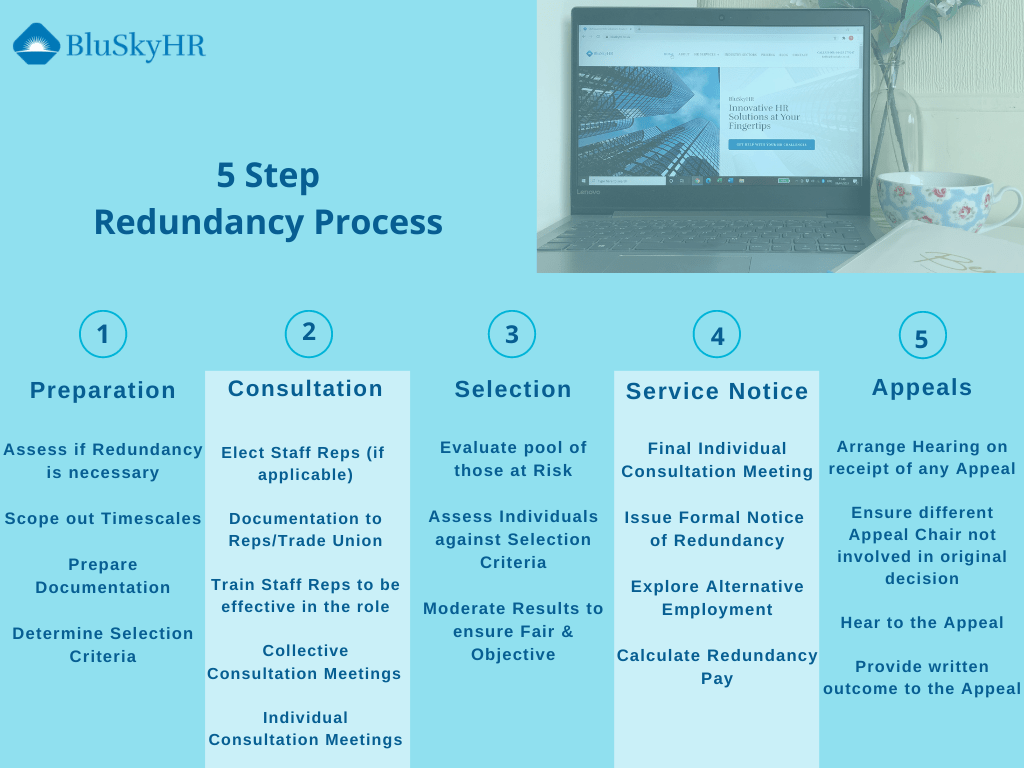Do you need to embark on Redundancies in 2021?
Want to understand your legal obligations as an employer? Read on…

The Furlough Scheme is coming to an end on 30 September 2021. What does that mean for businesses who have been reliant on the Government support packages? With one month left until employers will need to contribute towards Furloughed employees’ salaries, now is the time to focus on your future resourcing strategy.
One cost-saving solution that comes to mind is to reduce headcount by invoking redundancies. However, don’t underestimate how tough redundancy processes are to navigate. Not just for the employees at risk of redundancy but there is significant added pressure on you, the Business Owner, to ensure you don’t leave yourself open to an Employment Tribunal claim.
The magic ingredient to ‘Getting it Right’, is all about following a proper, fair, and lawful redundancy process.
This 5 step redundancy process provides a structured framework to follow. Also, check out the flowchart at the start of the article.
1. Preparation is Key!
a) Be clear on your reasons for invoking redundancies
Is ‘Redundancy’ the only choice? Or are there alternatives that you haven’t considered? Check out my recent Blog ‘Alternatives to Redundancies’. Alternatively, you could speak to an Insolvency Practitioner to see if they can provide any long-term solutions to help you avoid losing employees.
b) What people resource are you unable to do without?
You should have a clear idea of which roles are fundamental to the effective operation and success of your business but deciding which roles you need to lose is a tough call!
It often helps to start with documenting your existing Organisational Structure in the form of a chart. Then create a couple of different options as to how the structure of the department or business would look post-redundancy. What roles do you currently have? What tasks within those roles are you unable to do without? Are there opportunities to combine roles?
By giving pre-thought, planning, and being more creative with the resources you currently have, will go some way to help you make the right business decision. Creating a ‘current’ and ‘future’ resource model will also help when communicating your proposals to affected staff.
c) Ensure you have a robust Business Case

Understanding, and having a clear business rationale behind the reasons why you are embarking on a redundancy process is absolutely key to help your staff understand and acknowledge what is happening. Thus, minimising potential disputes arising.
Before you even enter the ‘Announcement stage’ of the process, whether that be face to face or via email, you need to be crystal clear of why you are reducing headcount. Is it because you need to make some significant cost cuts for the survival of the business? Have roles in the business changed, diminished, reduced? Do you need to restructure to ensure your business is fit for the future?
Whatever your reasons or justification for embarking on this process, ensure that you have a robust business case from the outset. If you need help writing the business case, BluSkyHR is on hand to help.
d) Prepare Timeline and Documentation
Scoping out a clear timeframe for the redundancy process enables all parties involved to understand their role in the process. This will ensure managers communicate to individuals and teams in a timely manner and it helps organise all parties involved in terms of their responsibilities throughout the process.
Having a written timeline will also ensure that the business meets the legal timeframe for collective consultation.
Like with all processes, you need to get your documentation in order to ensure that you meet your legal obligations, in terms of:
- communicating the reasons for the redundancies
- providing the opportunity for individual consultation
- giving the right to be accompanied to individual consultation meetings
- giving the employee the right of appeal.
This is particularly prevalent when you are dealing with employees who have full employment rights i.e. more than 2 years of service.
Redundancy is a dismissal and therefore a proper, legal process must be followed if you want to avoid an automatic unfair dismissal claim landing on your desk!

2. Consultation – What is that?
There is no minimum consultation period when making less than 20 redundancies in a 90 day rolling period. However, you need to demonstrate that you have consulted with affected staff and that the consultation is meaningful. After all, deciding the outcome from the outset, before seeking employee input, goes against the premise of fairness and transparency.
However, making 20 or more redundancies becomes a little trickier. Certainly, in terms of increasing the period between announcing redundancies and notifying of dismissal. This is because you are legally obliged to collectively consult with either Trade Union Representatives (if they exist in your business) or with Elected Employee Representatives.
But I hear you say, “What if we don’t have a recognised Trade Union or Elected Employee Representatives in our business?”
As long as you factor in contingency time to elect and nominate Employee Representatives, the process for Collective Consultation is relatively straightforward. Redundancy Blog 4 – Guide to Collective Consultation will go into this subject in more depth…watch this space!
3. Selection Process

Ensuring a fair and transparent selection process is essential to defending any future Employment Tribunal Claims. It is quite common to use a form of desktop assessment to conduct this exercise. Usually, criteria is scored on a scale of 1-5. Alternatively, Competency-Based Interviews could be useful as part of the selection process, particularly if scores are close on the desktop assessment.
If you have more than one individual undertaking a role of a similar nature and you need to reduce the pool of individuals, then ensure you use Selection Criteria that is objective and non-discriminatory. This could be criteria such as work performance, specific skills pertaining to the role, and qualifications.
Using criteria such as length of service should be avoided as this could be deemed age discriminatory. Absence records can be used as long as they aren’t related to reasons such as pregnancy or applied in a way to disadvantage someone with a protected characteristic, such as a Disability.
4. Serve Notice – The Final Meeting!
Probably the most difficult part of the whole process is notifying someone their role is redundant. It is important that this message is communicated in a sensitive and compassionate manner. The employee may not like the decision but if delivered in the right manner they won’t have any justification to challenge your decision.
Take the time to address any questions the employee may have, including communicating what their final remuneration package will be. Ensure that the decision is followed up in writing, providing the opportunity for the employee to appeal the decision.

5. Appeals
In accordance with Employment Rights Act 1996, employees with more than two years of service are entitled to appeal any dismissal decision, which includes a dismissal on the grounds of redundancy.
Failure to provide the right of appeal may go against you at an employment tribunal. Having a written policy in your Company Handbook or a Redundancy Policy that provides for this is useful, especially to provide timescales for when the employee must submit their appeal. However, communicating the right of appeal must be written into the final outcome letter.
For an appeal to be fair and objective, you would need to nominate a chair who has not been involved in the original dismissal decision. Again, the employee has the right to be accompanied. The appeal decision is the final part of the internal Company process.
What else do I need to know?
- Put everything in writing, so if you are challenged, you have evidence to demonstrate you have followed a fair and transparent Redundancy Process.
- Give employees the right to be accompanied to all individual Consultation Meetings. This can be either a Trade Union Representative or a fellow work colleague.
- Redundancy is a tough process for everyone involved, particularly employees who are at risk of losing their jobs. Make sure whoever is conducting the Consultation Meetings is trained to deal with difficult and emotional conversations. You need to have confidence they will deliver the news in a supportive and compassionate way.
- If you are potentially making 20 redundancies or more, you are required to notify the Government of this fact by completing an HR1 Advance Notice of Redundancy Form
- The ACAS Code of Practice provides more detailed information on the topic, should you need any additional bedtime reading! Alternatively, CIPD provides a useful Factsheet.
How can BluSkyHR help you?
We have a cost-effective Redundancy Support Package on offer, ideal for employers making less than 20 redundancies. For a no-obligation chat, please feel free to book a call via this link or email [email protected]
If you are making 20 or more redundancies, we can absolutely support you, whether you need a light-touch approach or a comprehensive support package.
Check out Part 4 Redundancy – Guide to Collective Consultation…coming soon!
